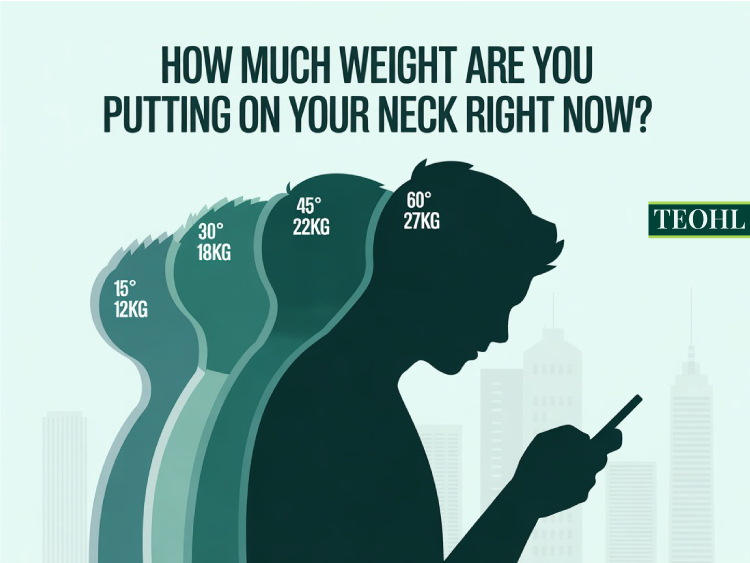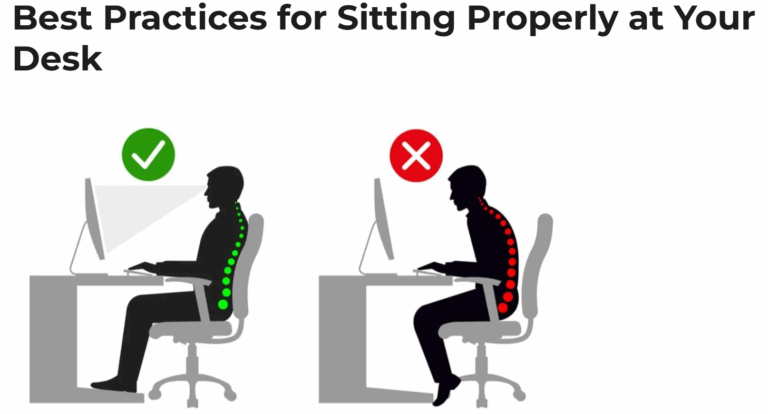Text Neck: The Hidden Danger of Smartphone Use and How to Protect Your Spine

That innocent downward glance at your phone? It’s putting up to 60 pounds of pressure on your neck right now.
Text neck is silently damaging millions of spines worldwide, and you might be its next victim. Every time you tilt your head forward to check your phone, you’re not just looking down—you’re dramatically multiplying the weight your neck has to support. Furthermore, this modern epidemic, known as text neck, is causing chronic pain, postural deformities, and long-term spinal damage in people as young as their twenties. In fact, the average person spends 3-5 hours daily on their phone, and with each degree your head tilts forward, the pressure on your cervical spine increases exponentially. Consequently, understanding text neck and how to prevent it isn’t just about comfort—it’s about protecting your long-term health and avoiding potentially irreversible damage to your spine.
Understanding Text Neck: The Physics of Forward Head Posture
Text neck occurs when you repeatedly tilt your head forward and down to look at digital devices, creating excessive strain on your cervical spine. Although the mechanics are straightforward, the results are alarming: your head weighs approximately 10-12 pounds (4.5-5.5 kg) in a neutral position. However, as you tilt it forward, the effective weight increases dramatically due to the physics of leverage and gravity.
Here’s the shocking breakdown of pressure on your neck based on head angle:
- 0° (neutral position): 10-12 kg of pressure
- 15° forward tilt: 12 kg of pressure (27 lbs)
- 30° forward tilt: 18 kg of pressure (40 lbs)
- 45° forward tilt: 22 kg of pressure (49 lbs)
- 60° forward tilt: 27 kg of pressure (60 lbs)
Think about that for a moment. At a 60-degree angle—the typical position when texting—your neck is supporting the equivalent weight of an 8-year-old child. Moreover, this continues for hours, every single day.
This isn’t just theoretical physics. In addition, research published in Surgical Technology International by Dr. Kenneth Hansraj demonstrates that this sustained forward head posture causes measurable damage to the cervical spine. As a result, medical professionals now recognize this condition as text neck syndrome.
The Anatomy of Text Neck Damage: What’s Happening to Your Spine
When you develop text neck, you’re not just experiencing temporary discomfort—you’re creating a cascade of structural changes in your body. Specifically, these changes include:
Cervical spine compression: The seven vertebrae in your neck (C1-C7) are designed to support your head in an upright position with a natural forward curve. Unfortunately, forward head posture reverses this curve, compressing the vertebrae and squeezing the intervertebral discs.
Muscle strain and imbalance: Your neck muscles—particularly the levator scapulae, upper trapezius, and sternocleidomastoid—must work overtime to support the increased weight. Meanwhile, the deep neck flexors weaken from disuse, creating a dangerous imbalance.
Nerve compression: As your head moves forward, it can compress nerves exiting the cervical spine. Consequently, this leads to radiating pain, numbness, or tingling down your arms and into your hands.
Ligament strain: The posterior ligaments of your neck stretch and weaken, while anterior structures shorten and tighten. Therefore, this creates a recipe for chronic instability.
Early spinal degeneration: Perhaps most concerning, sustained text neck posture accelerates degenerative changes in your cervical spine. Ultimately, this can lead to premature arthritis and disc herniation.
Text Neck Symptoms: Are You Already Affected?
Many people don’t realize they have text neck until symptoms become severe. Therefore, it’s important to watch for these warning signs:
Immediate symptoms:
- Neck pain and stiffness, especially after phone use
- Shoulder tension and upper back discomfort
- Headaches originating from the base of the skull
- Reduced range of motion when turning your head
Progressive symptoms:
- Chronic neck and shoulder pain that doesn’t resolve
- Visible forward head posture (your ear is ahead of your shoulder when viewed from the side)
- Rounded shoulders and upper back hunching
- Muscle spasms in the neck and upper back
- Pain that radiates down into the shoulders and arms
Advanced complications:
- Numbness or tingling in hands and fingers
- Difficulty maintaining upright posture
- Chronic headaches and migraines
- Jaw pain and TMJ problems
- Decreased lung capacity due to compressed chest cavity
- Early-onset spinal arthritis
If you’re experiencing any of these symptoms, you likely already have some degree of text neck damage. Fortunately, most cases can be reversed with proper intervention.
The Long-Term Consequences of Ignoring Text Neck
Left unchecked, text neck doesn’t just cause temporary discomfort—it creates lasting structural damage with far-reaching consequences. Indeed, these long-term effects include:
Permanent postural changes: Over time, the tissues in your neck adapt to the forward head position. As a result, it becomes increasingly difficult to maintain proper alignment even when you’re not using your phone.
Accelerated spinal aging: Research suggests that text neck can add 10-20 years of degenerative wear to your cervical spine. For instance, a 30-year-old with chronic text neck may have the spine of a 50-year-old.
Reduced quality of life: Chronic neck pain significantly impacts sleep quality, work productivity, mental health, and overall life satisfaction. Furthermore, studies show people with chronic neck pain have higher rates of depression and anxiety.
Increased healthcare costs: Treatment for chronic text neck complications—including physical therapy, medications, injections, and potentially surgery—can cost thousands of dollars over a lifetime.
Breathing and cardiovascular effects: Forward head posture compresses the chest cavity, reducing lung capacity by up to 30%. Consequently, this affects oxygen delivery throughout your body and can impact cardiovascular health.
How to Fix Text Neck: Practical Solutions That Work
The solution to text neck involves both prevention and active correction. Therefore, here’s your comprehensive action plan:
Immediate Positioning Changes for Text Neck Prevention
Lift your phone, don’t drop your head: This simple change is your first line of defense against text neck. Instead of bending down, hold your phone at eye level, bringing it up to your face rather than dropping your neck to the screen.
The 90-90 rule: When sitting, ensure your:
- Elbows are bent at 90 degrees
- Hips are at 90 degrees
- Phone or computer screen is at eye level
Create ergonomic workstations: Position computer monitors so the top of the screen is at or slightly below eye level, about an arm’s length away. Additionally, ensure proper lighting to reduce eye strain.
Use phone stands or holders: Invest in adjustable stands for your desk and car that keep devices at eye level. This way, you maintain neutral neck alignment throughout the day.
Text Neck Exercises and Stretches
Combat text neck with these targeted exercises. Ideally, perform them 2-3 times daily:
Chin tucks:
- First, sit or stand with shoulders relaxed
- Then, gently draw your chin straight back (like making a double chin)
- Hold for 5 seconds, repeat 10 times
- This strengthens deep neck flexors and reverses forward head posture
Neck extension stretches:
- Initially, place your hands on your forehead
- Next, gently press your head back against resistance
- Hold for 5-10 seconds, repeat 5 times
- This strengthens posterior neck muscles
Shoulder blade squeezes:
- Begin by sitting upright with arms at your sides
- Subsequently, squeeze your shoulder blades together
- Hold for 5 seconds, repeat 10 times
- This counteracts rounded shoulder posture
Doorway chest stretches:
- To start, place forearms on either side of a doorframe
- Then, step forward until you feel a stretch across your chest
- Hold for 30 seconds, repeat 3 times
- This opens the chest and reverses hunched posture
Upper trapezius stretches:
- First, sit tall and tilt your head toward one shoulder
- Afterward, gently pull with your hand for a deeper stretch
- Hold 30 seconds each side, repeat 3 times
- This releases chronic tension from phone use
Lifestyle Modifications for Text Neck Relief
Set phone time limits: Use built-in screen time tracking to become aware of usage patterns. Then, set realistic reduction goals. Apps like Forest or Freedom can help enforce limits.
Take regular breaks: Follow the 20-20-20 rule—every 20 minutes, look at something 20 feet away for 20 seconds. As a result, this gives your neck muscles a much-needed break.
Strengthen your core: A strong core supports proper posture throughout your entire spine. Therefore, reducing text neck risk becomes easier. Incorporate planks, bird dogs, and dead bugs into your routine.
Practice mindfulness: Develop body awareness by periodically checking in with your posture. Similarly, set hourly phone reminders to assess and correct your head position.
Optimize your sleep setup: Sleep on your back or side with proper pillow support that maintains neutral neck alignment. However, avoid stomach sleeping, which exacerbates text neck.
Text Neck in Children and Teens: A Growing Crisis
Text neck isn’t just an adult problem—it’s increasingly affecting children and adolescents whose spines are still developing. Moreover, this is particularly concerning because:
- Children’s bones are more malleable and susceptible to permanent deformation
- Kids today spend 7-10 hours daily on screens
- Many schools use tablets and laptops, increasing exposure
- Early-onset text neck can lead to lifelong postural problems
Parents should watch for:
- Complaints of neck or shoulder pain
- Visible forward head posture
- Resistance to physical activities
- Decreased academic performance due to discomfort
Prevention strategies for young people:
- Limit recreational screen time to 2 hours daily
- Ensure proper ergonomics for homework and gaming
- Encourage physical activities that promote good posture (swimming, yoga, martial arts)
- Model healthy device habits as a parent
- Schedule regular posture checks with pediatricians
When to See a Healthcare Professional About Text Neck
While many cases of text neck respond to self-care measures, certain symptoms warrant professional evaluation. Specifically, you should seek help when experiencing severe or persistent symptoms.
See a doctor or physical therapist if you experience:
- Neck pain lasting more than a few weeks
- Pain that radiates down your arms
- Numbness, tingling, or weakness in your hands
- Severe headaches that don’t respond to over-the-counter medications
- Difficulty performing daily activities due to neck pain
- Visible postural deformities
Treatment options may include:
- Physical therapy with manual techniques and therapeutic exercises
- Chiropractic adjustments to restore proper spinal alignment
- Massage therapy for muscle tension relief
- Acupuncture for pain management
- Ergonomic assessments for work and home environments
- In severe cases, medical interventions like injections or surgery
The Technology Solution: Apps and Tools to Combat Text Neck
Ironically, technology itself offers solutions to the text neck problem it created. In particular, these tools can help:
Posture reminder apps:
- Nekoze (iOS): Uses your phone’s camera to monitor head position and alerts you when posture deteriorates
- Text Neck Indicator (Android): Vibrates when you hold your phone at dangerous angles
- PostureScreen Mobile: Professional-grade posture analysis and tracking
Ergonomic accessories:
- Adjustable laptop stands (brands like Roost or Nexstand)
- Phone grips that encourage better holding positions
- Blue light glasses to reduce eye strain (which can worsen head forward posture)
- Standing desk converters for work-from-home setups
Wearable posture devices:
- Upright Go 2: Small device that buzzes when you slouch
- Lumo Lift: Tracks posture throughout the day and provides feedback
- Alex+ posture trainer: Uses gentle vibrations as reminders
Text Neck at Work: Creating a Spine-Friendly Office
Since many people spend 8+ hours daily at computers, workplace ergonomics are crucial for text neck prevention. Consequently, optimizing your workspace becomes essential:
Optimize your workstation:
- Monitor positioning: Top of screen at eye level, 20-28 inches from your face
- Chair adjustment: Feet flat on floor, knees at 90 degrees, lumbar support engaged
- Keyboard placement: Elbows at 90 degrees, wrists neutral
- Phone use: Speakerphone or headset instead of cradling phone against shoulder
Movement strategies:
- Stand and stretch every 30 minutes
- Walk during phone calls when possible
- Use standing desk options for portion of the day
- Take walking meetings instead of sitting in conference rooms
Employer initiatives:
- Request ergonomic assessments from HR
- Advocate for adjustable workstations
- Propose walking meetings and standing desks
- Share text neck awareness materials with colleagues
The Bottom Line on Text Neck: Small Changes, Big Impact
Text neck is a serious and growing health crisis. Nevertheless, it’s also entirely preventable and often reversible. In fact, the solution doesn’t require giving up your devices—it simply requires using them mindfully.
Every time you lift your phone to eye level instead of dropping your head, you’re choosing long-term spinal health over short-term convenience. Similarly, every chin tuck exercise strengthens the muscles that protect your neck. Additionally, every posture check prevents progressive damage.
Your spine is designed to last a lifetime, but only if you treat it with respect. Therefore, the small adjustments you make today—holding your phone higher, taking regular breaks, strengthening your neck muscles—will determine whether you enjoy pain-free mobility in your later years or struggle with chronic discomfort and disability.
The weight is literally in your hands. Ultimately, will you continue putting 60 pounds of pressure on your neck, or will you make the simple changes that protect your spine?
Start today. Lift your phone. Save your neck. Your future self will thank you.
If you’re experiencing persistent neck pain or postural problems, consult with a healthcare professional for personalized assessment and treatment. This article provides general information and should not replace medical advice.




